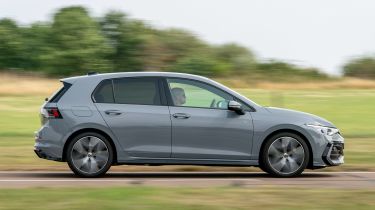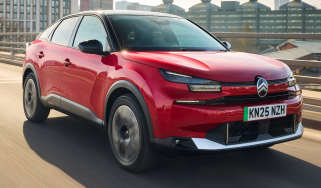Volkswagen Golf - MPG, CO2 and running costs
Mild and plug-in hybrid petrol engines help boost efficiency, offering low emissions and improved range

While the Volkswagen Golf has a reputation for bridging a gap between mainstream and premium hatchbacks, a starting price of around £27,000 certainly falls into the former camp. That figure looks very competitive on paper, because it undercuts the base-model Vauxhall Astra by more than £600 and the entry-level Ford Focus by almost £1,500. Things change at the top of the range, with the hot R model breaking the £43,000 mark. From time to time, some very tempting PCP finance deals are offered to encourage would-be customers to get behind the wheel of a VW, so the Golf might cost you less than expected.
And once behind the wheel, this German hatchback won’t cost a fortune to run, either. Officially, the 1.5 TSI petrol achieves 52.3mpg, which is a figure that would be tricky to match around town, but easy to match – or even beat – on more open roads. The diesels are better still, with their official 63.5mpg being similarly achievable on longer runs.
Volkswagen has introduced many features to improve the Golf’s green credentials. Plug-in and mild-hybrid versions, stop-start systems, and cylinder deactivation all feature in the model line-up, and should help customers make cost savings.
Company car users will be particularly taken with the revised Golf GTE thanks to its blend of performance, courtesy of its 268bhp combined output, and super-low CO2 emissions of 8g/km, while the plug-in model is able to cover around 81 miles on electric drive alone. Volkswagen claims the GTE will average 94.2mpg, although you'll need to ensure you regularly charge the battery to get near that figure.
Used - available now
The 201bhp eHybrid Style uses the same 1.5-litre petrol/plug-in hybrid system as the GTE, but overall efficiency improves, with up to 89 miles of electric-only range and CO2 emissions of 6g/km.
Diesel economy figures are also impressive. VW claims the 114bhp 2.0 TDI manual will manage around 64mpg, while the more powerful 148bhp auto version of the same engine will return around 60mpg. You might not reach those numbers in everyday driving, but you certainly won’t be a regular at the fuel station. Emissions are cleaner, too, with the same base car emitting as little as 117g/km of CO2.
The petrol cars provide an interesting mix. Delivering a claimed maximum of 52.3mpg, the 114bhp 1.5 TSI matches the 1.0-litre three-cylinder unit that it replaced, while adding the DSG gearbox (and its mild hybrid add-ons) boosts this figure to 53.4mpg.
It’s a similar story with the 148bhp 1.5 TSI, with the six-speed manual model offering 50.9mpg in the official combined figures, while the eHybrid with the seven-speed DSG automatic transmission manages up to 54.3mpg combined.
Customers looking towards the performance of the Volkswagen Golf GTI will see average economy of 39.8mpg and emissions of 162g/km, while the more powerful Volkswagen Golf GTI Clubsport version delivers slightly worse figures at 35.8mpg and 171g/km. The more powerful R model’s four-wheel drive system has a slight impact on efficiency, so it returns 34.9mpg and 184g/km of CO2.
|
Model |
MPG |
CO2 |
Insurance group |
|
Golf 1.5 eTSI 150 Life DSG |
54.3mpg |
119g/km |
20E |
|
Golf 2.0 TDI Match |
64.2mpg |
117g/km |
19E |
|
Golf 2.0 TSI R |
34.9mpg |
184g/km |
33E |
Electric range, battery life and charge time
Both the eHybrid and GTE plug-in hybrid versions of the Golf use a larger 25.7kWh (19.7kWh useable) battery pack that’s also found in plug-in versions of the Volkswagen Passat and Volkswagen Tiguan. That’s up from just 13kWh in the pre-facelift Golf, and allows for over 80 miles of electric-only range.
The maximum charging speed has been increased from just 3.6kWs to 40kWs, meaning if you plug into a suitably rapid charger, a 5-80 per cent top-up will take just 26 minutes. However, that’ll be an expensive way of replenishing the battery in your Golf compared with home charging. Official charging times utilising a more cost-effective 7.4kW wallbox charger haven’t been released for the Golf at the time of writing, but a Passat using the same 7.4kW charger is stated to take around four hours to go from flat to full, so we expect that to be the same for the Golf.
The battery pack in the Golf is covered by a separate warranty, and is expected to maintain above 70 per cent of its capacity for up to eight years or 100,000 miles, whichever comes first.
Tax
With the exception of the R and GTI Clubsport models that cost over £40,000 when new, all other Golfs in the range will cost between £180 and £190 in Vehicle Excise Duty from the second year on.
The cheapest model to run for company-car drivers is the Golf Style eHybrid PHEV. Thanks to its lowly five per cent Benefit-in-Kind banding, this version will cost basic-rate income taxpayers just £367 a year.
Insurance groups
The entry-level Golf Match 1.5 TSI starts from group 17 insurance, while performance versions climb much higher; the GTI is rated at group 31, and the R is group 33.
Depreciation
A used Golf normally holds on to its value fairly well, but in the Mk8 range, some models perform a little better than others. The petrol options hold their value best, with the numerous variants of the 1.5 TSI clinging on to roughly 48 per cent of their original price after three years or 36,000 miles.
The base diesel is just behind, at around 46.5 per cent over the same time period and mileage. The rest of the range, including the PHEVs and performance models, float between 40 and 43 per cent.
To get an accurate valuation for a specific model, check out our valuation tool...














